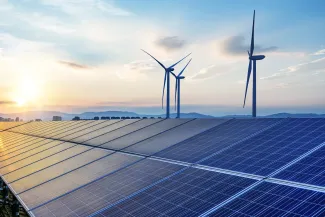
EarthTalk - What are energy droughts?
© iStock
Dear EarthTalk:
What are energy droughts and how can we get around them?
B.B., Houston, TX
Solar and wind power may be free and renewable, but they rely on natural processes that are beyond our control. Proponents of fossil fuels point out that if the sun doesn’t shine and the wind doesn’t blow for an extended period, the grid could suffer a so-called “energy drought” where there just isn’t enough power to meet the demand. A recent study by researchers at the U.S. Department of Energy’s Pacific Northwest National Laboratory (PNNL) found that in some parts of the U.S., such energy droughts are not uncommon and can last anywhere from a few hours to almost a week.
“For solar energy, it would be when it’s really cloudy or hazy, maybe even smoky. And for wind, it would be atmospheric conditions that just have no wind blowing,” says PNNL’s Cameron Bracken, lead author on the study. “When we have a completely decarbonized grid and depend heavily on solar and wind, energy droughts could have huge amounts of impact on the grid.”

There are several ways to mitigate the risk of energy droughts. For one, minimizing demand for energy—and reducing consumption via the adoption of energy-sipping appliances and devices—is pivotal in circumventing energy droughts. Implementing energy-saving technologies across industries, homes and transportation reduces overall demand, lessening strain on the grid during peak times. Initiatives promoting energy conservation, like better insulation, efficient appliances, and public transport systems, contribute significantly to offsetting energy scarcity and can be important hedges against energy droughts.
Furthermore, grid modernization is vital for best management of energy supply and demand. Smart grids with advanced monitoring and control technologies enhance reliability, detect faults promptly, and enable efficient energy distribution. Integrating energy storage solutions like batteries or pumped hydroelectric storage helps store excess energy during surplus times for use during shortages, enhancing grid stability. Another way to protect against crippling energy droughts is through the development of microgrids—small, controllable power systems composed of one or more generation units connected to nearby users that can function independently or in conjunction with the main grid. These microgrids can sustain essential services during larger grid outages, bolstering resilience against energy droughts.
Developing better energy storage systems, i.e. batteries, is key to the fossil-fuel-free grid of the future if it is to be fed by intermittent renewables like solar and wind. Tesla’s Powerwall, an integrated battery system that stores solar energy for backup when the grid goes down, is a great first step. But critics argue that we cannot tolerate the scale of lithium mining it would take to create enough lithium-ion batteries (the technology behind the Powerwall) to store enough energy to power a world without coal, natural gas and the other fossil fuels. A revolution in battery storage could prove to be key to whether or not we can successfully transition away from fossil fuels in time to save the planet from cataclysmic climate change.
CONTACTS
- 'Energy droughts' in wind and solar can last nearly a week, https://www.sciencedaily.com/releases/2023/12/231211200121.htm
- Pacific Northwest could experience ‘energy droughts,’ study finds, https://www.opb.org/article/2024/01/01/pacific-northwest-oregon-solar-wind-energy-outage-power-electricity/.
EarthTalk® is produced by Roddy Scheer & Doug Moss for the 501(c)3 nonprofit EarthTalk. See more athttps://emagazine.com. To donate, visit https://earthtalk.org. Send questions to: question@earthtalk.org















